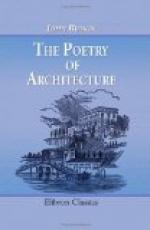First. The brick should neither be of the white, nor the very dark red, kind. The white is worse than useless as a color: its cold, raw, sandy neutral has neither warmth enough to relieve, nor gray enough to harmonize with, any natural tones; it does not please the eye by warmth, in shade; it hurts it, by dry heat in sun; it has none of the advantages of effect which brick may have, to compensate for the vulgarity which it must have, and is altogether to be abhorred. The very bright red, again, is one of the ugliest warm colors that art ever stumbled upon: it is never mellowed by damps or anything else, and spoils everything near it by its intolerable and inevitable glare. The moderately dark brick, of a neutral red, is to be chosen, and this, after a year or two, will be farther softened in its color by atmospheric influence, and will possess all the advantages we have enumerated. It is almost unnecessary to point out its fitness for a damp situation, not only as the best material for securing the comfort of the inhabitant, but because it will the sooner contract a certain degree of softness of tone, occasioned by microscopic vegetation, which will leave no more brick-red than is agreeable to the feelings where the atmosphere is chill.
192. Secondly. Even this kind of red is a very powerful color; and as, in combination with the other primitive colors, very little of it will complete the light, so, very little will answer every purpose in landscape composition, and every addition, above that little, will be disagreeable. Brick, therefore, never should be used in large groups of buildings, where those groups are to form part of landscape scenery: two or three houses, partly shaded with trees, are all that can be admitted at once. There is no object more villainously destructive of natural beauty, than a large town, of very red brick, with very scarlet tiling, very tall chimneys, and very few trees; while there are few objects that harmonize more agreeably with the feeling of English ordinary landscape, than the large, old, solitary, brick manor house, with its group of dark cedars on the lawn in front, and the tall wrought-iron gates opening down the avenue of approach.
193. Thirdly. No stone quoining, or presence of any contrasting color, should be admitted. Quoins in general (though, by the by, they are prettily managed in the old Tolbooth of Glasgow, and some other antique buildings in Scotland), are only excusable as giving an appearance of strength; while their zigzag monotony, when rendered conspicuous by difference of color, is altogether detestable. White cornices, niches, and the other superfluous introductions in stone and plaster, which some architects seem to think ornamental, only mock what they cannot mend, take away the whole expression of the edifice, render the brick-red glaring and harsh, and become themselves ridiculous in isolation. Besides, as a general principle, contrasts of extensive color are to be




